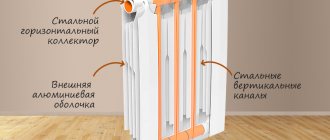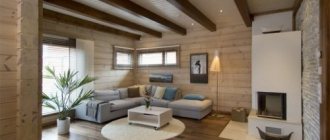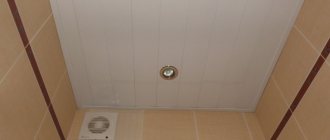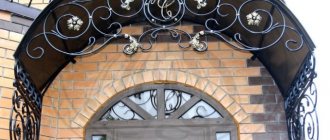When designing and installing autonomous heating systems in private households, various types of one- and two-pipe systems are used. Despite the fact that each of the options has the right to be used and applied in accordance with the prevailing conditions and circumstances, in terms of their performance indicators, the latter are more profitable and popular among homeowners. In turn, among two-pipe building heating systems, the dead-end heating system is the most popular. In the article we have prepared, we will tell you what a two-pipe dead-end building heating system is, what types of installation diagrams there are, and will highlight a number of other issues.
Principle of operation
The dead-end heating circuit is the most common circuit. Its fundamental difference from the associated system is that the coolant moves along the supply and return lines in different directions.
The flow of hot coolant moves along the supply line from the boiler towards the radiator system. The coolant enters the radiator, gives up its heat and is discharged into the return line, along which it moves immediately in the opposite direction - to the boiler.
Most often, a two-pipe dead-end heating system works when heating a private house using forced circulation of coolant with bottom wiring. This design makes it possible to use pipes of smaller diameter and significantly reduces the inertia of the system. In addition, it is applicable even with significant lengths of pipelines.
At the same time, the dead-end circuit makes it possible to implement a gravity-flow system with overhead distribution. Such systems are chosen mainly for their energy independence. There is no need to connect to the mains since there is no circulation pump used.
Installation
- You should not save too much money and time on installing the heating system.
- The heating main includes 2 pipes. One way the coolant is supplied to the radiators, and one way it returns to the boiler.
- The pipe supplying water to the batteries must be higher than the one that supplies water to the boiler.
- Do not skimp on radiator taps, bypasses and other devices that improve the operation of the heating system.
- Avoid sharp corners along the highway that could create traffic jams or resistance.
- The supply pipe must be well insulated, then there will be minimal heat loss.
- The expansion tank should also be installed in a warm place.
Boiler installation. This is the very first step. It is best when it is in a separate place. There must be good ventilation so that combustion products are ventilated. The walls and floor around it must be fireproof. In addition, the device must always be freely accessible for easy maintenance and monitoring. A pipe is led from it to the expansion tank. Circulation pump. It is installed after the boiler. Along with it, a manifold cabinet with all the necessary equipment is installed. Pipe wiring. They are carried out from the boiler to the places where the batteries are located
At this stage, it is important to be very careful and carefully connect the pipes. Connecting radiators. 2 pipes are connected to each device. A pipe is installed at the top that supplies the coolant, and at the bottom it carries away the cooled water.
The batteries themselves are mounted under the window on brackets. The battery should be located at a distance of about 100mm from the window sill, 20-50mm from the wall, 100-120mm from the floor. Shut-off valves are mounted on the sides of the radiator, thanks to which the battery will be turned off without disturbing the operation of the entire system. After completing the installation of radiators, you should carefully check the tightness of their connections to the pipes.
A pipe is installed at the top that supplies the coolant, and at the bottom it carries away the cooled water. The batteries themselves are mounted under the window on brackets. The battery should be located at a distance of about 100mm from the window sill, 20-50mm from the wall, 100-120mm from the floor. Shut-off valves are mounted on the sides of the radiator, thanks to which the battery will be turned off without disturbing the operation of the entire system. After completing the installation of radiators, you should carefully check the tightness of their connections to the pipes.
Types of dead-end heating systems
Depending on the organization of the pipeline layout, two types of dead-end heating systems are distinguished:
- horizontal;
- vertical (shoulder).
In the first case, the supply and return pipelines are located horizontally. They use pipes of the same diameters and mounting components of common standard sizes. This greatly simplifies the installation of a heating system in a private home.
The horizontal design allows you to maintain almost the same temperature in all radiators. However, its disadvantage is the increased complexity of balancing individual radiators with a significant length of heating system pipelines.
The vertical system is used in cases where it is necessary to heat a two-story house. In this case, the pipeline system is divided into two branches. The first branch runs along the first floor of the building. The second branch is led to the second floor through a vertical riser. Dead-end heating systems of this type are more complex.
For their stable and sustainable operation, a number of conditions must be met:
- the number of heating devices on each floor should not exceed 10;
- accurate calculation of pipeline diameters must be performed;
- installation of balancing valves with automatic pressure control should be provided on each floor;
- When installing a vertical dead-end system, the movement of coolant by gravity is excluded - a circulation pump must be used.
When installing a dead-end system of any type, the key importance is not only accurate calculation and qualified execution of work, but also the correct choice of radiators and components.
Ogint radiators are distinguished not only by high thermal efficiency and reliability, but also by excellent hydraulic characteristics. Our company also offers functional mounting elements. This allows you to create efficient and stably operating dead-end heating systems of horizontal and vertical types.
This may be useful
Below are some useful information and uses of polycarbonate.
- For fastening polycarbonate, manufacturers often supply special profiles of the same color as the polycarbonate panels themselves. The properties of profiles are absolutely no different from panels.
Docking profiles for polycarbonate
- If the polycarbonate is destroyed, parts of the panel do not pose a danger to others.
- You don't need any special tools to cut the panel into pieces.
- Polycarbonate is chemically resistant to almost all substances (with the exception of ammonia).
Cutting polycarbonate with a knife
Advantages and disadvantages compared to associated systems
For large wholesales (from 1000 pcs.) we are ready to offer the best conditions for our radiators →
A dead-end system is considered less progressive compared to a system with a parallel movement of the coolant. At the same time, it is more popular due to its simplicity.
A system with a parallel movement of coolant is superior to a dead-end system in hydraulic terms. In it, the coolant moves along the supply and return lines in one direction. Therefore, in both mains the water travels the same distance. This ensures an optimal balance of the heating system. Provided that the system uses radiators of the same power and standard size, the calculation will be as simple as possible, and the system itself does not require the installation of radiator valves for balancing, which have to be used in a dead-end system. However, in associated systems it is necessary to take into account the presence of so-called “points of equal pressure” in the two circuits. If you connect the radiator to the main line at such a point, then water will not flow into it. In dead-end systems this problem does not exist.
Another disadvantage of the counter circuit is that the last radiator in it is a dead end. In it, the coolant pressure will be less, which affects the thermal efficiency. Losses have to be compensated by adding additional sections or installing regulators on each radiator.
The main advantage of a heating system with dead-end coolant movement is its simplicity. Parallel sections of the pipeline, as well as fittings, have the same diameter. This simplifies and reduces the cost of installing the system. In addition, the dead-end system is characterized by a shorter length of pipelines, which also provides significant savings during installation.
Considering the existing advantages and disadvantages, as well as their relationship, dead-end systems have earned wide popularity. They are especially actively used for heating relatively small private houses, where the installation of a complex branched system is not required.
Radiators for a dead-end heating system:
Aluminum radiators
Pros and cons of two-pipe wiring
For ease of perception, we have combined the advantages and disadvantages of all the above systems into one section. First, let's list the key positive points:
- The only advantage of gravity flow over other schemes is independence from electricity. Condition: you need to select a non-volatile boiler and install it without connecting to the house electrical network.
- The shoulder (dead-end) system is a worthy alternative to the Leningradka and other single-pipe distributions. The main advantages are versatility and simplicity, thanks to which a two-pipe heating circuit for a house of 100-200 m² can be easily installed with your own hands.
- The main advantages of the Tichelman loop are hydraulic balance and the ability to provide coolant to a large number of radiators.
- Manifold wiring is the best solution for hidden pipe laying and complete automation of heating operation.
The best way to hide pipes is to lay them under the floor screed
Note. The last 3 schemes can be easily combined with water underfloor heating circuits. Combining a gravity radiator network with heated floors is not always advisable - without electricity, forced circulation in heating circuits is impossible.
Let us briefly highlight the general advantages of the beam, associated and dead-end systems:
- small sections of distribution pipes;
- flexibility in terms of laying, that is, lines can run along different routes - in floors, along and inside walls, under ceilings;
- Various plastic or metal pipes are suitable for installation: polypropylene, cross-linked polyethylene, metal-plastic, copper and corrugated stainless steel;
- All 2-pipe networks lend themselves well to balancing and thermal regulation.
To hide the pipe connections, you need to cut grooves in the wall.
Let's note a minor advantage of gravity wiring - the ease of filling and removing air without the use of valves and taps (although with them it is easier to ventilate the system). Water is slowly supplied through the fitting at the lowest point, air is gradually forced out of the pipelines into an open-type expansion tank.
Now about the significant disadvantages:
- The scheme with natural water movement is cumbersome and expensive. You will need pipes with an internal diameter of 25...50 mm, installed with a large slope, ideally steel. Hidden installation is very difficult - most elements will be visible.
- No significant disadvantages were found in the installation and operation of dead-end branches. If the arms differ greatly in length and number of batteries, balance is restored through deep balancing.
- The Tichelman ring wiring routes always intersect doorways. You have to make bypass loops, where air can subsequently accumulate.
The house plan shows that the associated water system crosses 2 doorways - Beam-type wiring requires financial costs for equipment - manifolds with valves and rotameters, plus automation equipment. An alternative is to assemble a comb from polypropylene or bronze tees with your own hands.
Addition. To automatically regulate the heat transfer of batteries during gravity flow, you will need special radiator valves with an increased flow area.
Kromax IDEAL-4
Our TOP continues with another representative of Kromax. The IDEAL-4 bracket is an excellent solution in cases where you want to mount the TV on the wall and do not need to rotate it from time to time. This tilting bracket is ideal for both small TVs and large panels with screen sizes up to 65 inches. The reinforced design allows it to withstand loads of up to 50 kilograms. A huge number of mounting holes will allow you to install a TV from any manufacturer. This bracket is also notable for its minimum distance to the wall, which is only 23 millimeters, which allows you to install the TV almost flush against the wall and there will be no large gaps when viewed from the side. As for the installation, you can do it yourself. The design of the bracket has a built-in level that will allow you to position it parallel to the floor and ceiling so that your TV hangs perfectly level. Also, the design of the bracket provides the ability to adjust the angle of the TV from 0 to 10 degrees and there is protection against falls, which will eliminate the risk of damage to expensive equipment.
- Inclined.
- Diagonal: 22 - 65 inches.
- Distance from wall: 23 mm.
- Tilt angle: 0 - 10⁰.
- Max. load: 50 kg.
- Built-in level.
- Fall protection.
- VESA holes: from 50x50 mm.
Installation recommendations
If the work of assembling the system will be carried out with his own hands, then the master will need a step-by-step description of the installation process.
It is important to follow these rules:
- it is required to equip 2 circuits: for hot and cold water;
- pipes must be laid with a slight slope directed towards the last radiator;
- both contours are laid parallel to each other;
- to prevent heat loss in the main riser, it is better to wrap it with an insulator;
- installation of a container to collect excess water is carried out at the highest point;
- the dimensions of the pipes and connecting parts must match;
- all parts of the system are made of the same material.
The sequence of work is as follows:
- Diverting the main riser from the boiler. An expansion tank is installed here.
- Dividing supply pipes.
- Simultaneous laying of a pipe through which cold liquid is supplied to the boiler.
- Fixing the pump.
- Attaching batteries or radiators.
Before refueling 2-pipe heating systems, you need to carefully inspect whether all connections are securely tightened.
What is a salt lamp
This is an ordinary lamp, the lampshade of which is made from a single piece of rock salt. This salt is mined mainly in the Carpathians and Himalayas. Halite may contain impurities in the form of algae, plants or other minerals. Due to this, salt blocks come in different shades. Rock salt contains 84 natural elements and helps restore the body.
A salt lamp can serve as an unusual decoration for your home. Recently, salt monoliths, mainly due to advertising, are considered useful and healing. But is this really so? Let's figure out whether the salt monolith is useful or can it harm?
The child is safe
Pipeline materials
The modern market for building materials and the variety of heating equipment also dictate new solutions in the selection of materials for heating systems. Both the duration of operation of heating systems and the technical parameters of the purchased equipment (boilers, pumps, radiators) depend on the material from which the pipelines are made.
Steel pipelines of heating systems have been used for a long time in engineering systems. This is due to the fact that in Russia it will not be difficult to purchase such a pipe in the shortest possible time, and the price of systems made from steel pipes is the lowest. Steel pipelines are also resistant to high temperatures, temperature deformations are almost zero, and withstand hydraulic shocks well. But at the same time they have low corrosion resistance, so steel pipes are not recommended to be laid in building structures, that is, they must be installed in a hidden way. Thanks to all these advantages and disadvantages, the scope of application of steel pipe heating systems remains central heating and multi-storey budget housing construction.
Pipelines for heating systems made of copper are widely used in premium heating systems, since, despite all the advantages of copper, the price of such pipelines is the highest among analogues. Copper has the highest strength and heat resistance, withstanding pressures of about 200-400 bar and high temperatures up to 300°C. This allows the pipelines to be used both in central heating systems, where the coolant temperature can be about 150 °C, and in technological communications. The form of release of flexible copper pipelines of small diameters in coils allows for fairly quick and simple installation, laying pipes in building structures, having previously insulated them. Disadvantages of pipelines include the susceptibility of pipelines to electrochemical corrosion and the danger of destruction from stray currents. Therefore, it is strictly forbidden to use copper heating system pipes in combination with aluminum radiators.
Metal-plastic pipelines are used in independent heating systems where the coolant temperature does not exceed 95 °C. Due to their form factor (the pipe is supplied flexible in coils in sections of 25 or 50 meters), such pipelines are convenient to use for both underfloor heating and hidden installation. Due to low oxygen permeability, metal-plastic is not subject to corrosion. The disadvantages of metal-plastic pipes include the rather high cost of connecting fittings.
The most common option for installing heating system pipelines is the use of polypropylene pipes. This is the most inexpensive material, connected to each other using permanent solder fittings. But it should be remembered that for high-temperature environments, in particular for heating systems, only polypropylene pipes with a reinforced layer should be used. This type of pipe can withstand temperatures of no more than 95 °C, has a smooth inner surface, and, therefore, reduced hydraulic resistance. The disadvantages of polypropylene include low operating temperature, as well as the possibility of deformation and destruction of the chemical structure under the influence of sunlight. Therefore, polypropylene pipelines installed in an open manner must be covered with a layer of insulation.











